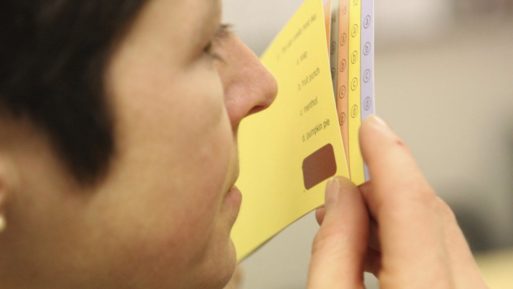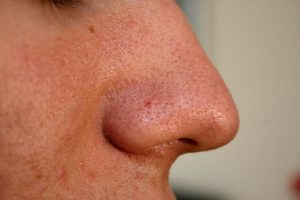
Credit: Vimeo.com
What if you could detect the early stages of Alzheimer’s using only your nose? A group of researchers is developing a new odor test that they think could help doctors identify patients who have the disease.
In two recent studies, researchers discovered that people who have trouble identifying common odors, like licorice or coffee, are more likely to have Alzheimer’s or other memory problems.
They studied two separate groups of people over the age of 60 and asked them to identify common smells. Each participant was given a set of scratch and sniff cards that contained different odors, such as cinnamon, chocolate or raspberry. Those who were able to correctly identify the scents were less likely to have or develop memory problems, whereas those who couldn’t identify the scents were more likely to develop Alzheimer’s or dementia later in life.
The Columbia University researchers decided to study the relationship between odors and Alzheimer’s after noticing that many Alzheimer’s patients complained that their favorite foods no longer taste the same. Doctors suspected that the patients’ sense of smell might be to blame.

Credit: Wikimedia.org
Smell affects the taste of food in two ways. First, certain chemicals in the food produce a unique aroma, and that aroma is detected in the olfactory region (located in the nasal cavity and back of the mouth). If you lose your sense of smell, you also lose the ability to distinguish between different tastes. You can still tell whether a food tastes salty or sweet. But you’re unable to tell the difference between an apple and a potato.
Second, the brain plays an essential role in the sense of taste and smell. The region of the brain responsible for identifying odors also happens to be the same region of the brain that Alzheimer’s impacts first. Patients in the early stages of the disease often experience a change in their sense of smell or taste as that region of the brain degenerates.
In theory, doctors could use a similar odor test on patients to detect whether their brains are processing smells correctly. Currently, tests for Alzheimer’s are prohibitively expensive for most patients. A PET scan that detects plaque on the brain costs thousands of dollars. The odor test would be far less expensive and could be done in a doctor’s office in only a few minutes.
More Research Still Needed
However, researchers warn that the test is far from foolproof. To start, other factors can impact a patient’s sense of smell. If the patient is a heavy smoker, has a stuffy nose or has a disease like Parkinson’s (which also impacts the odor detection centers of the brain), that could also affect their sense of smell.

Credit: Pixabay.com
Additionally, these two studies are relatively small. It’s still unclear how many Alzheimer’s patients experience a loss of their sense of smell as the disease progresses.
So far, doctors and researchers suspect that the odor test could be an adjunct to other behavioral tests already used to detect Alzheimer’s. Many doctors look for symptoms such as forgetfulness, sudden changes in mood, jumbled speech or restlessness. In the future, they might add a failed sniff test to their list of warning signs.
Researchers are making progress when it comes to identifying Alzheimer’s. However, they still don’t have a cure for the disease. For this reason, early diagnosis doesn’t always help patients. Until researchers find a cure for Alzheimer’s, the sniff test can only help patients and their families prepare before the disease progresses.

 A New Odor Test Could Detect the Early Stages of Alzheimer’s
A New Odor Test Could Detect the Early Stages of Alzheimer’s




 Harmony Amidst Change: Japan’s Kezouin Fuchu-shi Cemetery
Harmony Amidst Change: Japan’s Kezouin Fuchu-shi Cemetery














